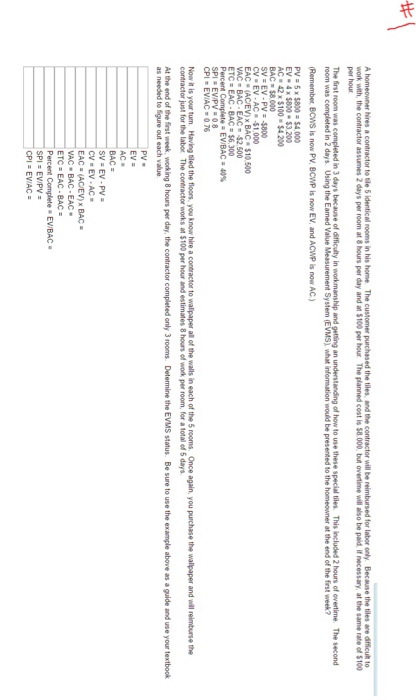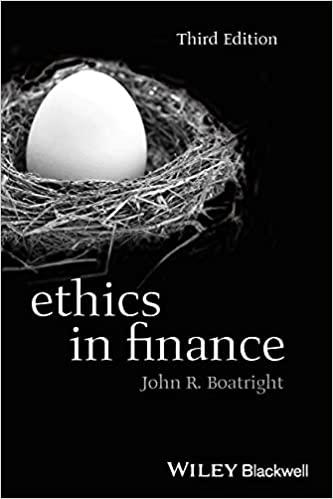A homeowner hires a contractor to the 5 identical rooms in his home The customer purchased the tiles, and the contractor will be reimbursed for labor only Because the ties are difficult work with, the contractor assumes 2 days per room at 8 hours per day and at $100 per hour. The planned cost is $8,000, but overtime will also be paid if necessary, at the same rate of $100 per hour. The first room was completed in 3 days because of difficulty in workmanship and getting an understanding of how to use these special tiles This included 2 hours of overtime. The second room was completed in 2 days. Using the Earned Value Measurement System (EVMS) what information would be presented to the homeowner at the end the first week? (Remember BCWS is now PV BCWP is now EV and ACWP is now AC) PV = 5 times $800= $4,000 EV = 4 times $800 = $3, 200 AC= 42 times $100 = $4.200 BAC = $8,000 SV = EV = PV = $800 CV= EV - AC= $1,000 EAC = (AC/EV) times BAC =$10.500 VAC= BAC-EAC= $2, 500 ETC= EAC- BAC= $6, 300 Percent Complete = EV/BAC= 40% SPi = EV/PV =0.8 CPi= EVAC =0.76 Now it is your turn Having tiled the floors, you know hire a contractor to walpaper all of the walls in each of the 5 rooms once again, you purchase the wallpaper and will reimburse the contractor just for the labor The contractor works at $100per hour and estimates 8 hours of work per room, for a total of 5 days. At the end of the week, working 8 hours per day, the contractor completed only 3rooms. Determine the EVMS status. Be sure to use the example above as a guide and use your textbook as needed to figure out each value. PV= EV= AC= BAC= SW= EV-PV= CW = EV-AC= EAC=(AC/EV) times BAC = VAC = BAC = EAC= ETC = EAC-BAC= percent complete=EV/BAC= SPI = EV/PV CPI=EV/AC = A homeowner hires a contractor to the 5 identical rooms in his home The customer purchased the tiles, and the contractor will be reimbursed for labor only Because the ties are difficult work with, the contractor assumes 2 days per room at 8 hours per day and at $100 per hour. The planned cost is $8,000, but overtime will also be paid if necessary, at the same rate of $100 per hour. The first room was completed in 3 days because of difficulty in workmanship and getting an understanding of how to use these special tiles This included 2 hours of overtime. The second room was completed in 2 days. Using the Earned Value Measurement System (EVMS) what information would be presented to the homeowner at the end the first week? (Remember BCWS is now PV BCWP is now EV and ACWP is now AC) PV = 5 times $800= $4,000 EV = 4 times $800 = $3, 200 AC= 42 times $100 = $4.200 BAC = $8,000 SV = EV = PV = $800 CV= EV - AC= $1,000 EAC = (AC/EV) times BAC =$10.500 VAC= BAC-EAC= $2, 500 ETC= EAC- BAC= $6, 300 Percent Complete = EV/BAC= 40% SPi = EV/PV =0.8 CPi= EVAC =0.76 Now it is your turn Having tiled the floors, you know hire a contractor to walpaper all of the walls in each of the 5 rooms once again, you purchase the wallpaper and will reimburse the contractor just for the labor The contractor works at $100per hour and estimates 8 hours of work per room, for a total of 5 days. At the end of the week, working 8 hours per day, the contractor completed only 3rooms. Determine the EVMS status. Be sure to use the example above as a guide and use your textbook as needed to figure out each value. PV= EV= AC= BAC= SW= EV-PV= CW = EV-AC= EAC=(AC/EV) times BAC = VAC = BAC = EAC= ETC = EAC-BAC= percent complete=EV/BAC= SPI = EV/PV CPI=EV/AC =







